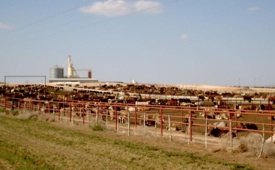
 December 17, 2010 –
December 17, 2010 –
Farmers throughout the country now have access to a new tool that can help them
lower air emissions and focus their environmental actions.
December 17, 2010 –
Farmers throughout the country now have access to a new tool that can help them
lower air emissions and focus their environmental actions.
More than 20 university professionals
and 15 partner agencies, including Western United Dairymen, joined forces to
create the National Air Quality Site Assessment Tool (NAQSAT), a method for
determining where air-quality improvement opportunities exist on their farms.
 |
|
NAQSAT was developed
mainly for educational purposes, and using it is completely voluntary,
explained Deanne Meyer, Livestock Waste Management Specialist at University of
California – Davis who helped design the tool. Though results may be more
valuable when NAQSAT is used in cooperation with Extension educators, agency
personnel, trade associations, or private consultants, it is completely
Internet-based and can be done privately. It isn’t designed to provide
emissions data and/or regulatory direction, but to help producers who are
looking for guidance.
Swine, dairy, beef,
broiler chicken, laying hen and turkey farmers can use NAQSAT. It addresses
eight management categories that relate to air emissions: animals and housing,
feed and water, collection and transfer of manure, manure storage, land
application, mortalities, on-farm records and public perception.
Users of the tool are
asked a series of questions under each category. Only questions that pertain to
the operation currently being evaluated will be asked. Pop-up pictures assist
the user in determining the relative rating to select when questions require a
visual evaluation of the existing practices. NAQSAT allows users to run
different scenarios to compare proposed changes in management and/or emission
mitigation practices. Different management techniques or new mitigation
practices may result in tradeoffs where the new practice reduces the emission
of one constituent of concern while at the same time increasing the emission of
another. Running multiple scenarios of NAQSAT identifies these tradeoffs before
producers invest large sums in control practices that don’t fully meet their
needs or goals.
“Whether it is a large
operation worried about greenhouse gas emissions or a small farm worried about
public image and odor, NAQSAT provides valuable insight for farmers,” said Paul
Martin, WUD director of environmental services, who was part of the development
team.
NAQSAT is available online
at http://naqsat.tamu.edu.
All sessions are strictly
confidential, and no farm identification is required to access the tool. Thanks
to a partnership with the Livestock and Poultry Environmental (LPE) Learning
Center, beef and dairy producers can learn how to use the tool in a webcast
found at http://bit.ly/NAQSATBeefDairy.